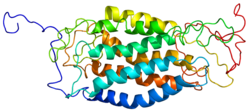CCR5
CCR5(C-C hemokinski receptor tip 5,CD195) jeproteinna površinibelih krvnih zrnca.On je komponentaimunskog sistemakoja deluje kaoreceptorzahemokine.Mnoge formeHIV-a, virusa koji uzrokujeAIDS,inicijalno koriste CCR5 da uđu i inficiraju ćelije domaćina. Mali broj osoba imamutacijupoznatu kaoCCR5 delta 32na CCR5genu,koja ih zaštićuje od tih vrsta HIV-a.
Kod ljudi,CCR5gen koji kodira CCR5 protein jelociranna kratkoj(p) ruciu poziciji 21hromozoma 3.Pojedine populacije su nasledileDelta 32mutaciju koja je dovela dogenetičke delecijeporcije CCR5 gena.Homozigotninosioci ove mutacije su otporni naM-tropne lozeHIV-1 infekcije.[1]
Funkcija
[уреди|уреди извор]CCR5 protein pripada familijibeta hemokinskih receptora,integralnih membranskih proteina.[2][3]On jeG protein spregnuti receptor[2]koji deluje kaohemokinski receptoruCC hemokinskoj grupi.
Prirodni hemokinskiligandikoji se vezuju za ovaj receptor suRANTES(hemotaksnicitokinskiprotein koji je takođe poznat kao CCL5)[4][5][6]imakrofagni inflamatorni protein(MIP) 1αi 1β(takođe poznat kaoCCL3iCCL4). On isto tako formira interakcije saCCL3L1.[5][7]
CCR5 je predominantnoizražennaT ćelijama,makrofagama,dentritskim ćelijamaimikroglijama.Smatra se da CCR5 učestvuje u inflamatornom odgovoru na infekciju, mada njegova specifična uloga u normalnim imunskim funkcijama nije potpuno razjašnjena.
Reference
[уреди|уреди извор]- ^Samson M, Libert F, Doranz BJ, Rucker J, Liesnard C, Farber CM, Saragosti S, Lapoumeroulie C, Cognaux J, Forceille C, Muyldermans G, Verhofstede C, Burtonboy G, Georges M, Imai T, Rana S, Yi Y, Smyth RJ, Collman RG, Doms RW, Vassart G, Parmentier M (1996). „Resistance to HIV-1 infection in caucasian individuals bearing mutant alleles of the CCR-5 chemokine receptor gene”.Nature.382(6593): 722—5.PMID8751444.doi:10.1038/382722a0.
- ^аб„Genetics Home Reference”.Архивирано изоригинала24. 09. 2009. г.Приступљено08. 04. 2012.
- ^Samson M, Labbe O, Mollereau C, Vassart G, Parmentier M (1996). „Molecular cloning and functional expression of a new human CC-chemokine receptor gene”.Biochemistry.35(11): 3362—7.PMID8639485.doi:10.1021/bi952950g.
- ^Slimani H, Charnaux N, Mbemba E, Saffar L, Vassy R, Vita C, Gattegno L (2003). „Interaction of RANTES with syndecan-1 and syndecan-4 expressed by human primary macrophages”.Biochim. Biophys. Acta.1617(1-2): 80—8.PMID14637022.doi:10.1016/j.bbamem.2003.09.006.
- ^абStruyf S, Menten P, Lenaerts JP, Put W, D'Haese A, De Clercq E, Schols D, Proost P, Van Damme J (2001). „Diverging binding capacities of natural LD78beta isoforms of macrophage inflammatory protein-1alpha to the CC chemokine receptors 1, 3 and 5 affect their anti-HIV-1 activity and chemotactic potencies for neutrophils and eosinophils”.Eur. J. Immunol.31(7): 2170—8.PMID11449371.doi:10.1002/1521-4141(200107)31:7<2170::AID-IMMU2170>3.0.CO;2-D.
- ^Proudfoot AE, Fritchley S, Borlat F, Shaw JP, Vilbois F, Zwahlen C, Trkola A, Marchant D, Clapham PR, Wells TN (2001). „The BBXB motif of RANTES is the principal site for heparin binding and controls receptor selectivity”.J. Biol. Chem.276(14): 10620—6.PMID11116158.doi:10.1074/jbc.M010867200.
- ^Miyakawa T, Obaru K, Maeda K, Harada S, Mitsuya H (2002). „Identification of amino acid residues critical for LD78beta, a variant of human macrophage inflammatory protein-1alpha, binding to CCR5 and inhibition of R5 human immunodeficiency virus type 1 replication”.J. Biol. Chem.277(7): 4649—55.PMID11734558.doi:10.1074/jbc.M109198200.
Literatura
[уреди|уреди извор]- Wilkinson D (1997). „Cofactors provide the entry keys. HIV-1”.Curr. Biol.6(9): 1051—3.PMID8805353.doi:10.1016/S0960-9822(02)70661-1.
- Broder CC, Dimitrov DS (1997). „HIV and the 7-transmembrane domain receptors”.Pathobiology.64(4): 171—9.PMID9031325.doi:10.1159/000164032.
- Choe H; Martin KA; Farzan M; et al. (1998). „Structural interactions between chemokine receptors, gp120 Env and CD4”.Semin. Immunol.10(3): 249—57.PMID9653051.doi:10.1006/smim.1998.0127.
- Sheppard HW; Celum C; Michael NL; et al. (2002). „HIV-1 infection in individuals with the CCR5-Delta32/Delta32 genotype: acquisition of syncytium-inducing virus at seroconversion”.J. Acquir. Immune Defic. Syndr.29(3): 307—13.PMID11873082.
- Freedman BD, Liu QH, Del Corno M, Collman RG (2004). „HIV-1 gp120 chemokine receptor-mediated signaling in human macrophages”.Immunol. Res.27(2–3): 261—76.PMID12857973.doi:10.1385/IR:27:2-3:261.
- Esté JA (2004). „Virus entry as a target for anti-HIV intervention”.Curr. Med. Chem.10(17): 1617—32.PMID12871111.doi:10.2174/0929867033457098.
- Gallo SA; Finnegan CM; Viard M; et al. (2003). „The HIV Env-mediated fusion reaction”.Biochim. Biophys. Acta.1614(1): 36—50.PMID12873764.doi:10.1016/S0005-2736(03)00161-5.
- Zaitseva M, Peden K, Golding H (2003). „HIV coreceptors: role of structure, posttranslational modifications, and internalization in viral-cell fusion and as targets for entry inhibitors”.Biochim. Biophys. Acta.1614(1): 51—61.PMID12873765.doi:10.1016/S0005-2736(03)00162-7.
- Lee C; Liu QH; Tomkowicz B; et al. (2004). „Macrophage activation through CCR5- and CXCR4-mediated gp120-elicited signaling pathways”.J. Leukoc. Biol.74(5): 676—82.PMID12960231.doi:10.1189/jlb.0503206.
- Yi Y; Lee C; Liu QH; et al. (2004). „Chemokine receptor utilization and macrophage signaling by human immunodeficiency virus type 1 gp120: Implications for neuropathogenesis”.J. Neurovirol.10 Suppl 1: 91—6.PMID14982745.
- Seibert C, Sakmar TP (2004). „Small-molecule antagonists of CCR5 and CXCR4: a promising new class of anti-HIV-1 drugs”.Curr. Pharm. Des.10(17): 2041—62.PMID15279544.doi:10.2174/1381612043384312.
- Cutler CW, Jotwani R (2006). „Oral mucosal expression of HIV-1 receptors, co-receptors, and alpha-defensins: tableau of resistance or susceptibility to HIV infection?”.Adv. Dent. Res.19(1): 49—51.PMID16672549.doi:10.1177/154407370601900110.
- Ajuebor MN, Carey JA, Swain MG (2006). „CCR5 in T cell-mediated liver diseases: what's going on?”.J. Immunol.177(4): 2039—45.PMID16887960.
- Lipp M, Müller G (2006). „Shaping up adaptive immunity: the impact of CCR7 and CXCR5 on lymphocyte trafficking”.Verhandlungen der Deutschen Gesellschaft für Pathologie.87:90—101.PMID16888899.
- Balistreri CR; Caruso C; Grimaldi MP; et al. (2007). „CCR5 receptor: biologic and genetic implications in age-related diseases”.Ann. N. Y. Acad. Sci.1100:162—72.PMID17460174.doi:10.1196/annals.1395.014.
- Madsen HO; Poulsen K; Dahl O; et al. (1990).„Retropseudogenes constitute the major part of the human elongation factor 1 alpha gene family”.Nucleic Acids Res.18(6): 1513—6.PMC330519
 .PMID2183196.doi:10.1093/nar/18.6.1513.
.PMID2183196.doi:10.1093/nar/18.6.1513. - Uetsuki T, Naito A, Nagata S, Kaziro Y (1989). „Isolation and characterization of the human chromosomal gene for polypeptide chain elongation factor-1 alpha”.J. Biol. Chem.264(10): 5791—8.PMID2564392.
- Whiteheart SW; Shenbagamurthi P; Chen L; et al. (1989). „Murine elongation factor 1 alpha (EF-1 alpha) is posttranslationally modified by novel amide-linked ethanolamine-phosphoglycerol moieties. Addition of ethanolamine-phosphoglycerol to specific glutamic acid residues on EF-1 alpha”.J. Biol. Chem.264(24): 14334—41.PMID2569467.
- Ann DK; Wu MM; Huang T; et al. (1988). „Retinol-regulated gene expression in human tracheobronchial epithelial cells. Enhanced expression of elongation factor EF-1 alpha”.J. Biol. Chem.263(8): 3546—9.PMID3346208.
- Brands JH; Maassen JA; van Hemert FJ; et al. (1986). „The primary structure of the alpha subunit of human elongation factor 1. Structural aspects of guanine-nucleotide-binding sites”.Eur. J. Biochem.155(1): 167—71.PMID3512269.doi:10.1111/j.1432-1033.1986.tb09472.x.
Vidi još
[уреди|уреди извор]Spoljašnje veze
[уреди|уреди извор]- Video i tekst o otkriću CCR5-a
- „Chemokine Receptors: CCR5”.IUPHAR Database of Receptors and Ion Channels.International Union of Basic and Clinical Pharmacology. Архивирано изоригинала18. 01. 2021. г.

